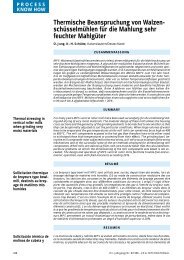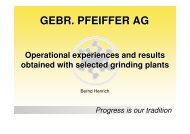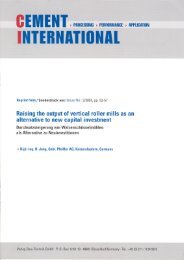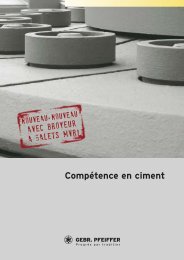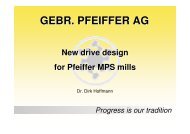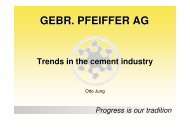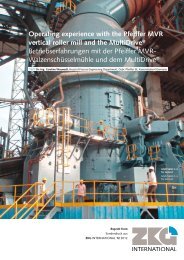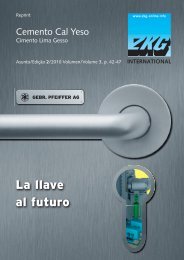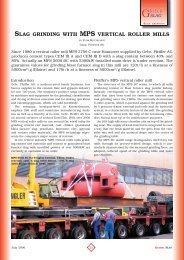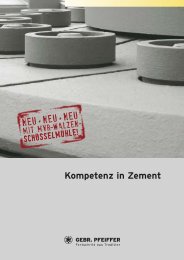than meets the eye - Gebr. Pfeiffer SE
than meets the eye - Gebr. Pfeiffer SE
than meets the eye - Gebr. Pfeiffer SE
You also want an ePaper? Increase the reach of your titles
YUMPU automatically turns print PDFs into web optimized ePapers that Google loves.
COAL GRINDING<br />
IMPS: more <strong>than</strong> <strong>meets</strong> <strong>the</strong> <strong>eye</strong><br />
by Dr Caroline Woywadt &<br />
Rüdiger Sonnen,<br />
<strong>Gebr</strong> <strong>Pfeiffer</strong> <strong>SE</strong>, Germany<br />
Vertical roller mills are not only used for grinding cement raw materials but<br />
also find an application in grinding a wide variety of coal types in cement<br />
and power plants. <strong>Gebr</strong> <strong>Pfeiffer</strong> <strong>SE</strong> (GP<strong>SE</strong>) describes its vertical roller mills<br />
for coal grinding and provides a case study of an MPS225BK installed at<br />
CBR’s Lixhe cement works in Belgium.<br />
Customers from all over <strong>the</strong> world<br />
rely on <strong>Gebr</strong> <strong>Pfeiffer</strong>’s MPS and<br />
MVR vertical roller mill solutions<br />
for grinding cement raw material, clinker<br />
and granulated blast furnace slag. The<br />
MPS technology, however, is also applied<br />
in numerous installations simultaneously<br />
grinding and drying coal for use in cement<br />
plants, power stations and in <strong>the</strong> steel<br />
industry. In <strong>the</strong>se plants very different<br />
coal types like anthracite, bituminous<br />
coal or lignite and also various kinds of<br />
petcoke are processed. Two mill systems<br />
are employed for most coal grinding<br />
applications in <strong>the</strong> cement industry. These<br />
are, on <strong>the</strong> one hand, vertical roller mills<br />
that have achieved a share of almost 90<br />
per cent and, on <strong>the</strong> o<strong>the</strong>r, ball mills whose<br />
share is recorded at just over 10 per cent 1 .<br />
Mill design features<br />
and benefits<br />
GP<strong>SE</strong> supplies stand-alone MPS coal<br />
grinding mills as well as complete coal<br />
grinding-drying systems. Both mill and<br />
grinding system can be operated under<br />
pressure or suction as well as under<br />
air or inert gas atmosphere. System<br />
configurations cover grinding plants with<br />
temporary storage of <strong>the</strong> pulverised coal<br />
in silos (cement works, blast-furnaces in<br />
steel plants, etc) and installations with<br />
direct injection into <strong>the</strong> combustion system<br />
(power generating plants). For over 40<br />
Figure 2: MPS series for coal grinding mills<br />
Figure 1: MPS coal<br />
grinding mill with SLS<br />
high-efficiency classifier<br />
years <strong>the</strong> MPS mills for power stations<br />
have been manufactured under licence<br />
by Hitachi Power Europe GmbH (formerly<br />
Babcock Borsig AG), headquartered in<br />
Oberhausen, Germany.<br />
The MPS vertical roller mill is<br />
characterised by its statically-determinate<br />
system which consists of a<br />
pressure frame, three rollers<br />
and three external pull rods,<br />
and ensures <strong>the</strong> load is<br />
uniformly distributed to <strong>the</strong><br />
grinding table. The table is<br />
driven by an electric motor<br />
and a gearbox. During<br />
start-up and maintenance<br />
<strong>the</strong> rollers can be lifted by<br />
tensioning cylinders.<br />
A high-efficiency SLS<br />
classifier is mounted above<br />
<strong>the</strong> grinding zone. The<br />
feeding device for fresh<br />
material is arranged in this<br />
area where <strong>the</strong> fresh feed<br />
is also mixed with <strong>the</strong> grits<br />
rejected from <strong>the</strong> classifier<br />
(see Figure 1). The main<br />
difference between an<br />
MPS mill for solid fuels and<br />
o<strong>the</strong>r MPS mills lies in its<br />
pressure-shock resistance.<br />
Mill and classifier housing,<br />
feed unit and expansion<br />
joints are designed pressureshock<br />
resistant. To avoid<br />
accumulations of coal dust<br />
as a source of spontaneous<br />
combustion, all surfaces in<br />
<strong>the</strong> grinding and classifying<br />
zone are vertical or inclined.<br />
The key features of a coal<br />
grinding plant in a cement<br />
works are:<br />
• special layout of <strong>the</strong> plant<br />
to avoid coal dust deposits<br />
• pressure shock-resistant<br />
design of mill and classifier<br />
housing, filter and pulverised<br />
coal silos<br />
• use of rapid-action flaps, rupture disks<br />
and explosion vents in certain parts of <strong>the</strong><br />
plant<br />
• monitoring of O 2 , CO and dust<br />
concentration levels in critical places<br />
• supply of CO 2 in <strong>the</strong> event of safetyrelevant<br />
limit values being exceeded<br />
• if possible, reducing <strong>the</strong> O 2<br />
concentration level in <strong>the</strong> dust-laden gases<br />
to 8-12 per cent by using kiln exhaust gas<br />
and by minimising <strong>the</strong> amount of false air<br />
• automated linking of all safety-relevant<br />
data and process control features of <strong>the</strong><br />
entire plant<br />
Figure 2 shows <strong>the</strong> MPS series for coal<br />
grinding mills. Depending on <strong>the</strong> fuel to<br />
be ground throughput rates of 5-200tph<br />
can be achieved in a fineness range<br />
INTERNATIONAL CEMENT REVIEW NOVEMBER 2012
COAL GRINDING<br />
between one per cent R0.063mm and 25<br />
per cent R0.090mm.<br />
The MPS coal grinding mill with a high<br />
drying capacity is very suitable for grinding<br />
lignites with feed moistures of as much as<br />
45 per cent. Depending on this high feed<br />
moisture, <strong>the</strong> mill rating is determined<br />
by drying whereas for anthracite, hard<br />
coal and petcoke <strong>the</strong> rating of <strong>the</strong> mill<br />
is determined by grinding. The great<br />
variety of solid fuel properties, such as<br />
grindability, ash content, volatiles as well<br />
as <strong>the</strong> required product fineness, calls<br />
for a wide range of operating states. The<br />
hydropneumatic tension system allows <strong>the</strong><br />
stepless adjustment of roller force to suit<br />
<strong>the</strong> wide range of solid fuel feed materials.<br />
In combination with <strong>the</strong> adjustable airflow<br />
rate <strong>the</strong> mill control range is between<br />
30-100 per cent. Part-load operation<br />
may become necessary as a result of load<br />
variations in injection-type grinding mills<br />
installed in power plants, changing fuel<br />
qualities and a grindability o<strong>the</strong>r <strong>than</strong> that<br />
specified in <strong>the</strong> design criteria.<br />
CBR Lixhe case study<br />
Project scope<br />
In 2010 HeidelbergCement AG decided<br />
to set up a new, modern coal grinding<br />
plant at CBR in Lixhe, Belgium. The new<br />
plant was to replace <strong>the</strong> existing grinding<br />
technology with a view to increasing<br />
<strong>the</strong> energy efficiency and achieving<br />
environmental constraints. The coal<br />
grinding plant was ordered from GP<strong>SE</strong> in<br />
April 2010.<br />
The target was to install a new grinding<br />
plant in accordance with technical<br />
and legal standards for coal grinding.<br />
Important conditions were attached to<br />
<strong>the</strong> order. The new coal mill had to be<br />
integrated into <strong>the</strong> present plant layout<br />
while existing foundations and building<br />
parts had to be reused. In addition, <strong>the</strong><br />
shutdown of <strong>the</strong> complete plant was<br />
limited to two months, starting with<br />
<strong>the</strong> demolition of <strong>the</strong> existing plant and<br />
ending with <strong>the</strong> start of commissioning of<br />
<strong>the</strong> new grinding plant.<br />
GP<strong>SE</strong>’s scope of supply covered <strong>the</strong><br />
following components:<br />
• MPS 225 BK vertical roller mill,<br />
• pressure shock-resistant, self-purifying<br />
rotary feeder<br />
• airtight reject box<br />
• SLS 1800 BK high-efficiency classifier<br />
• set of dampers, safety dampers and<br />
expansion joints<br />
• measuring and control equipment<br />
• water injection system.<br />
All required engineering services<br />
were provided by GP<strong>SE</strong> in very close<br />
coordination with HeidelbergCement<br />
Technology Center (HTC):<br />
• detailed engineering<br />
• quality inspection plans<br />
• erection schedules<br />
• maintenance and operating manuals<br />
• preparation of ATEX certificates<br />
• staff training on operation, maintenance<br />
and repair.<br />
The customer who<br />
requested that <strong>the</strong> mill<br />
foundation and <strong>the</strong><br />
building structure be<br />
reused was responsible<br />
for <strong>the</strong> filter,<br />
including explosion<br />
protection, <strong>the</strong> mill<br />
fan, <strong>the</strong> ductwork,<br />
<strong>the</strong> civil works, <strong>the</strong><br />
electrical installations<br />
and <strong>the</strong> erection<br />
of <strong>the</strong> mechanical<br />
equipment.<br />
Legal basis<br />
The European Directive 94/9/EG dated 23<br />
March 1994 (ATEX) defined for <strong>the</strong> first<br />
time basic health and safety requirements<br />
relating to non-electric equipment<br />
intended for use in areas with danger of<br />
explosion. In particular, this applies to<br />
<strong>the</strong> protection of workers against risks<br />
arising from <strong>the</strong> use of equipment and<br />
protective systems in potentially-explosive<br />
atmospheres. Belgium, as a member of<br />
<strong>the</strong> European Union, is subject to this<br />
directive and <strong>the</strong>refore, <strong>the</strong> new coal<br />
grinding plant at CBR Lixhe had to be<br />
planned, constructed and operated in<br />
compliance with <strong>the</strong> legislation. The basic<br />
requirements of <strong>the</strong> ATEX directive had<br />
to be complied with and evidence of<br />
compliance had to be provided.<br />
This applied not only to <strong>the</strong> mill but also<br />
to <strong>the</strong> components supplied along with<br />
<strong>the</strong> mill such as rotary feeder or safety<br />
dampers. In particular <strong>the</strong> protective<br />
systems, eg <strong>the</strong> quick-action dampers,<br />
had to comply with <strong>the</strong> requirements laid<br />
down in this directive. The supplier had to<br />
issue an ATEX declaration of conformity.<br />
The documents submitted in connection<br />
with <strong>the</strong> coal mill in Lixhe were checked<br />
and certified by <strong>the</strong> TÜV Rhineland<br />
technical inspection authority.<br />
Figure 3: process diagram for CBR, Lixhe,<br />
coal grinding installation<br />
Plant layout<br />
Figure 3 shows <strong>the</strong> plant process diagram.<br />
The coal is fed into <strong>the</strong> MPS 225 BK (2)<br />
through a pressure shock-resistant, selfpurifying<br />
rotary feeder (1). After being<br />
dried, ground and classified in <strong>the</strong> mill<br />
system, <strong>the</strong> finished product extracted<br />
from <strong>the</strong> classifier (3) is collected in a<br />
bag filter, discharged from <strong>the</strong> filter via<br />
screw conveyors and a rotary feeder. The<br />
product is <strong>the</strong>n conv<strong>eye</strong>d pneumatically to<br />
<strong>the</strong> coal intermediate silo.<br />
Rapid-action dampers (5) are installed<br />
in <strong>the</strong> gas ducts before and after <strong>the</strong> mill,<br />
serving as a safety system in addition to<br />
<strong>the</strong> mill, filter and silo being inerted with<br />
CO 2 .<br />
The filter and silos are equipped with<br />
pressure relief valves to vent <strong>the</strong> shock<br />
wave and to release possible flames into<br />
<strong>the</strong> atmosphere in case of an explosion.<br />
Measurements of CO, O 2 and dust<br />
are taken downstream of <strong>the</strong> filter for<br />
monitoring <strong>the</strong> grinding plant. CO<br />
and temperature are monitored in <strong>the</strong><br />
pulverised coal silo. If <strong>the</strong> preset limits of<br />
CO and O 2 concentration are reached, <strong>the</strong><br />
safety systems, such as safety dampers,<br />
CO 2 inertisation of <strong>the</strong> mill, filter and silo,<br />
are activated.<br />
The MPS 225 BK has a grinding table<br />
diameter of 2.25m. The three φ1.5m<br />
grinding rollers are equipped with tyres<br />
made of Magotteaux-XWin ® – a wearresistant<br />
material consisting of granulated<br />
ceramic material combined with a high<br />
chrome alloy in a casting process. The<br />
installed power at <strong>the</strong> main gearbox is<br />
500kW. The high-efficiency classifier SLS<br />
1800 BK is equipped with a 22kW-rated<br />
drive. The rating of <strong>the</strong> mill was based on<br />
<strong>the</strong> well-known Hardgrove grindability<br />
test 2.<br />
NOVEMBER 2012 International cement review
COAL GRINDING<br />
Figure 4 (above): <strong>the</strong> new<br />
foundation placed onto <strong>the</strong><br />
existing floor ra<strong>the</strong>r <strong>than</strong><br />
embedded in <strong>the</strong> ground<br />
Figure 5 (right): <strong>the</strong><br />
preassembled mill housing<br />
Project execution<br />
and erection<br />
The planning phase was followed by<br />
delivery, installation and commissioning.<br />
The installation phase was characterised<br />
by strictly-organised site logistics because<br />
not only erection activities were carried<br />
out but also <strong>the</strong> internal procedures of<br />
<strong>the</strong> cement works had to be taken into<br />
consideration. The foundation inside <strong>the</strong><br />
building had to be reused. Figure 4 shows<br />
<strong>the</strong> new foundation that is not embedded<br />
into <strong>the</strong> ground but placed on <strong>the</strong> existing<br />
floor of <strong>the</strong> building.<br />
Erection conditions were difficult due<br />
to lack of space. Figure 5 shows <strong>the</strong><br />
logistical challenges of transporting <strong>the</strong><br />
preassembled mill housing into <strong>the</strong> mill<br />
building.<br />
A very narrow space was provided for<br />
<strong>the</strong> classifier platform and <strong>the</strong> classifier<br />
itself. Installation of <strong>the</strong> upper classifier<br />
parts was a challenge for <strong>the</strong> fitters and<br />
crane drivers (Figure 6). Ductwork was<br />
redesigned inside <strong>the</strong> building.<br />
Optimised procedures enabled <strong>the</strong><br />
erection inside <strong>the</strong> building and <strong>the</strong><br />
completion of <strong>the</strong> plant within a period of<br />
only 32 days.<br />
Operating experience<br />
No-load tests of <strong>the</strong> coal grinding plant<br />
started in March 2011, followed by<br />
commissioning and plant takeover in<br />
April 2011. The performance test was<br />
conducted in June 2011 and <strong>the</strong> mill<br />
was guaranteed to grind 34tph of coal<br />
with feed moisture ranging between<br />
8-16 per cent. The ash content of <strong>the</strong><br />
coal lies between 13-22 per cent and<br />
<strong>the</strong> grindability according to Hardgrove<br />
between 64-67. The required fineness<br />
is less <strong>than</strong> seven per cent R0.090mm.<br />
Table 1 gives <strong>the</strong> guaranteed figures and<br />
<strong>the</strong> production figures that have been<br />
achieved. The new coal grinding plant<br />
fully <strong>meets</strong> <strong>the</strong> expectations in terms of<br />
production capacity and operating values.<br />
General references in<br />
coal grinding<br />
More <strong>than</strong> 1000 MPS mills<br />
are being used worldwide<br />
for processing various<br />
types of coal, ranging from<br />
lignite to petcoke, including<br />
different kinds of hard coal<br />
and anthracite.<br />
Commissioning of<br />
many coal grinding mills<br />
is currently in progress – for example, in<br />
India where an MPS 3070 BK grinding<br />
58tph of lignite at 15 per cent R0.090mm<br />
is in operation at Jaiprakash Associates’<br />
Balaji cement plant and an MPS of same<br />
size for hard coal grinding at a steelworks<br />
with a throughput of 60tph at 17.5 per<br />
cent R0.090mm.<br />
In Ukraine, <strong>the</strong> erection of an MPS 200<br />
BK for coal grinding is completed, and<br />
commissioning will start soon.<br />
In Sudan, an MPS 250 BK set up at<br />
Al Shamal plant has recently passed <strong>the</strong><br />
acceptance test, producing 30tph of<br />
petcoke at three per cent R0.090mm.<br />
In addition, several MPS 3550 BK mills<br />
with an installed power of 1300kW that<br />
were sold to different cement plants in<br />
India are in <strong>the</strong> order processing stage.<br />
Conclusion<br />
To meet market demands for flexibility<br />
in terms of grinding and drying <strong>the</strong> most<br />
diverse range of solid fuels, GP<strong>SE</strong> has<br />
continuously developed and enhanced<br />
<strong>the</strong> process and design criteria of <strong>the</strong><br />
MPS coal grinding mill. Vertical roller mills<br />
in general are <strong>the</strong> most energy-efficient<br />
and reliable systems for this broad range<br />
of applications.__________________I<br />
References<br />
1ONESTONE INTELLIGENCE GMBH<br />
(2009) “Cement Projects Focus 2013”,<br />
Multi-Client Market Report. 12/2009,<br />
Buxtehude, Germany.<br />
2 KRAFT, B AND REICHARDT, Y (2005)<br />
“Grinding of solid fuels using MPS vertical<br />
roller mills” in: ZKG International 58, No<br />
11, p36-47.<br />
Table 1: guaranteed and achieved parameters for<br />
pulverised coal<br />
Parameter Guarantee Actually achieved<br />
Throughput rate – dry (tph) 34 36.2<br />
Finished product fineness (% – R0.090mm)




